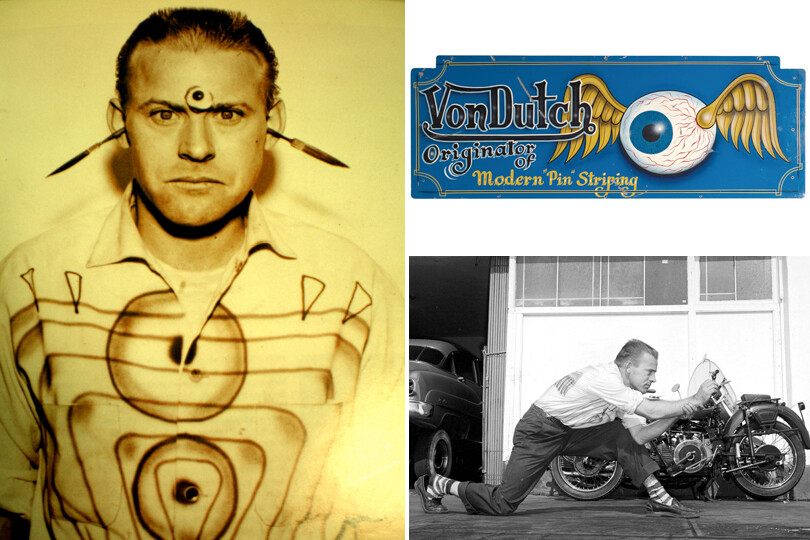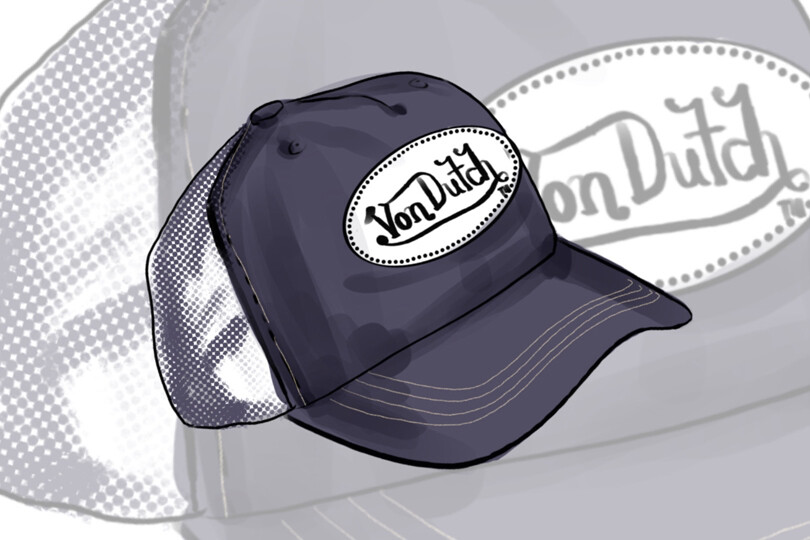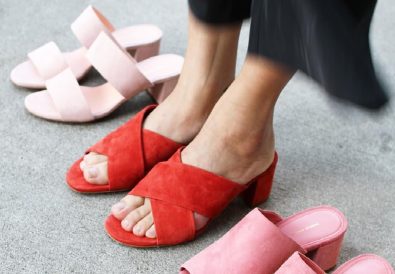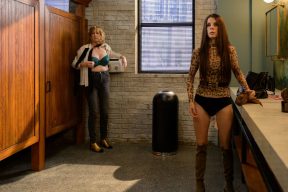Part of an ongoing series of 29Secrets stories, taking a deep dive into the history of legendary beauty products and iconic fashion and pop culture moments…
By Christopher Turner
Illustration by Michael Hak
For a brief moment in fashion history, Von Dutch was the biggest brand in the world. In the early 2000s, Von Dutch – a casual line of denim, T-shirts, jackets and trucker hats, all featuring an instantly recognizable Von Dutch logo – showed up everywhere from rowdy college campuses to the red carpet in Hollywood. Von Dutch was also a staple in our television diet: from MTV and beyond, the biggest stars in the world, including Paris Hilton, Madonna, Britney Spears, Gwen Stefani, Jay-Z, Dennis Rodman, Justin Timberlake and Ashton Kutcher, all wore the label, intrinsically linking the brand (and especially the trucker hat) to that very specific era of celebrity.
But how did Von Dutch manage to make a trucker hat the most coveted fashion item, and how did the brand go from unknown to a pop culture phenomenon to overexposed to a joke in just a few years? It turns out that the brand’s downfall had a lot more behind it than just the ebb and flow of fashion trends. Here’s the story of how an art dealer, a convicted drug dealer, a competitive-surfer-turned-small-time-gangster and a world martial arts champion all had a hand in launching one of the most memorable fashion brands of all time.
The real Von Dutch
The real “Von Dutch” had nothing to do with the fashion label named after him. Kenneth Robert Howard was a motorcycle mechanic and car detailer turned mid-century artist who lived in California and often worked under the name Von Dutch. Family members had originally given him the nickname “Dutch” because he was “as stubborn as a Dutchman,” according to a book published by the Laguna Art Museum in Laguna Beach, California. Howard added the “Von” prefix later as an artistic signature. He pioneered the contemporary art of pinstriping – customizing cars and motorcycles with thin, decorative lines – and created a number of memorable drawings throughout his career, including his most famous, a flying eyeball with wings that is meant to symbolize “all past lives are watching what you do in the present.” Howard was also the father of the Kustom Kulture movement that would heavily influence the fashion and style of hot rodding, surf culture, skateboarding and rock ’n’ roll. His lifelong struggle with alcoholism led to his death at the age of 63 on September 19, 1992.

After Howard’s death, Los Angeles-based art collector Ed Boswell (who was a fan of Howard’s art) began selling small Von Dutch patches at various LA art shows, having secured the rights to the Von Dutch name from Howard’s daughters Lisa and Lorna.
The drug dealer and the surfer
In the mid-1990s, Boswell met California-based duo Michael Cassel (a former drug dealer and self-described “outlaw” who served four years in San Quentin State Prison after a cocaine bust) and his prodigy Robert “Bobby” Vaughn (a competitive surfer and model, who narrowly evaded arrest after his involvement in a 1993 shooting) at a trade show. The three men ultimately decided to go into business together, creating the original Von Dutch clothing line. After a short period of time, Cassel and Vaughn bought Boswell out of the company.
Cassel and Vaughn were no strangers to launching a clothing line: the duo had created the successful surf-skate brand Bronze Age in the early ’90s. The original idea for the Von Dutch apparel line was for it to be a collection of jeans and workwear, which would nod to Howard’s garage-themed work and feature some of his more memorable drawings, including the flying eyeball with wings. Some of their first designs for Von Dutch, introduced in 1997, included logo tanks and flame-printed trucker hats and jeans. (Fun fact: Many of the Von Dutch jeans that were sold were actually Dickies jeans; the two men simply picked off the Dickies labels and reworked the jeans to their own tastes with a Von Dutch label.)
By the late ’90s, Cassel and Vaughn’s Von Dutch label had built up a small but loyal following among rebels and outcasts in the Los Angeles area. “Kids go through a stage where they like punk rock, they like rebellious things, and ‘f–k that’ anarchy, right? He was that in his art, he was that in his actions, he was completely against the grain,” Cassel said of Howard’s appeal.
Unfortunately, Cassel’s criminal record made it almost impossible to secure the financing needed to grow the label. So, not long after Boswell’s exit from the company, Cassel went on the hunt for a private investor to help bring things to the next level. He found one in Tonny Sorensen, a wealthy six-foot-six former Olympian and tae kwon do champion from Denmark who had originally come to Los Angeles to pursue a career as an action star. After Sorensen moved to LA in 1991, he purchased a hot rod Cadillac and became involved in southern California car culture – and particularly interested in the father of the Kustom Kulture movement, Kenneth “Von Dutch” Howard. Intrigued by the man, Sorensen set out to make a film about Von Dutch’s life, which led him to Cassel. After a bit of back and forth, Cassel brought Sorensen on to serve as an investor, and CEO of the company, in 2000.
Von Dutch was starting to get noticed in Hollywood, thanks to Vaughn’s social connections. The brand’s first big boost came when rocker Tommy Lee wore a Von Dutch T-shirt on his 2000 episode of MTV Cribs, a prime placement that Vaughn had arranged. It was huge for Von Dutch.
So the brand was catching on…but, unfortunately, it wasn’t making any money. By 2001, the Von Dutch brand was more than $600,000 USD in debt. At first, Sorensen – who took 51 per cent control of the brand with a million-dollar investment – and Cassel shared a similar vision for Von Dutch, but as time passed and Sorensen found himself losing a lot of money, he decided to make some big changes and switch things up.
Bling empire
In 2002, Sorensen hired a French designer named Christian Audigier in an attempt to boost Von Dutch’s sales. Audigier – who would eventually launch a line of notorious tattoo-inspired T-shirts called Ed Hardy – had an entirely different vision for the brand than Cassel and Vaughn’s original vision for Von Dutch. Audigier was obsessed with celebrity culture (especially Michael Jackson), sequins and lots of bling, and he immediately started experimenting with low-rise, flared jeans that were trending at the time. Of course, they immediately started to sell.
As Von Dutch’s popularity started to rise, there were some serious problems behind the scenes, and things went downhill fast for Cassel and Vaughn. Sorensen found sneaky ways to have both Cassel and Vaughn forgo their stakes in the brand. Cassel and Vaughn saw this as a form of betrayal, and began to turn on each other. Vaughn made threats against Cassel; Cassel made threats against Sorensen, even at one point hiring an accomplice of Colombian drug lord Pablo Escobar to visit the Von Dutch offices and threaten Sorensen. It didn’t work, and by the end of 2022 Sorensen became sole owner of the Von Dutch brand.
“They took this thing that I created, my baby, and they prostituted it,” Cassel said.
The trucker hat
Nothing says Von Dutch like the iconic Von Dutch trucker hat, but there are discrepancies over its origins. Both Cassel and Vaughn claim that they came up with the idea before Sorensen became part of the company, while Sorensen claims he’s the one who came across vintage pinstripe and herringbone fabrics in the company’s offices, and had the brainstorm of making trucker hats out of them with the Von Dutch logo. The official story is that it was Audigier who came up with the trucker hat, inspired by classic Americana such as Marlon Brando’s motorcycle cap in The Wild One. However, Audigier is arguably the least likely person to have come up with the idea.
Whoever came up with the original idea, the plan to sell the trucker hats at a luxury price point was definitely Sorensen’s idea, and it worked. When they were first launched in-store, they sold out instantly. “People didn’t know what [Von Dutch] meant,” former professional basketball player and noted Von Dutch fanatic Dennis Rodman says in the docuseries The Curse of Von Dutch: A Brand to Die For. “They just wanted to wear it.”
Paris Hilton also remembers being instantly drawn to the brand through the hats, which were available in a dizzying selection of colours and prints. “It was playful, cute and iconic,” she says in the docuseries. “[It was all about] standing out and a lot of bling. It was so much fun.”
As the trucker hats picked up steam, Von Dutch also began working with Tracey Mills, who was friends with many celebrities and acted as a brand ambassador by introducing them to the label. “Back then, a celebrity was unattainable,” says Mills. “There was no social media. When you did get to see them in something, it was a craze to get it.”
Capturing star power
Celebrities played a vital role in Von Dutch’s rapid rise to global fame. The early 2000s were the prime years for the company and celebrities were constantly spotted wearing a variety of Von Dutch apparel such as jackets, T-shirts and, most notably, trucker hats. Madonna and Jay-Z were some of the first big names spotted by the paparazzi wearing the trucker hat. Britney Spears and Justin Timberlake were also fans of the brand, and when their breakup made national news in 2002, they happened to be wearing Von Dutch trucker hats on the cover of People magazine. Ashton Kutcher was constantly seen wearing Von Dutch in the early 2000s, especially on episodes of MTV’s hidden camera–practical joke reality television series Punk’d. But the true peak was when Paris Hilton and Nicole Richie began wearing Von Dutch on The Simple Life. Hilton remembers going to the Von Dutch store in LA before filming and meeting Audigier. “He gave us whatever we wanted,” says Hilton. “We came out with 50 shopping bags, and that was our uniform for the show.”

The exposure from The Simple Life ensured that Von Dutch sales exploded. The brand not only recovered from its debts but actually began doubling its profits every month. Sales reached over $33 million in 2003 and went as high as $100 million in 2004. And it was all thanks to the parade of celebrities who constantly wore Von Dutch trucker hats. The brand’s relationship with celebrities was so important that Von Dutch had a policy of never charging celebrities for anything they picked out at the stores. Once, Whitney Houston and her entire entourage stopped by the LA store and requested one of every single item.
“I said to them, ‘Have you ever heard her voice? Have you ever heard her sing? Do you remember The Bodyguard? Like, give her 30 bags, because she’s the best singer I’ve ever heard in my life and I still get goosebumps,’” says Sorensen.
The “Von-Douche” era and the decline of the brand
The good times didn’t last: Von Dutch began to experience a rapid decline by the end of 2004. Counterfeit products became a huge issue – the brand claims it was the second-most counterfeited label at the time, aside from Louis Vuitton – and the oversaturation of Von Dutch essentially killed its cool factor, especially as Audigier began collaborating with seemingly random labels.
“It became too much,” says Hilton. “You saw it everywhere. It used to be cool people wearing it, then all of a sudden this cheesy, random crowd started wearing it. I remember one day I looked in my closet and I had so much Von Dutch, and I just couldn’t look at it anymore. I got rid of everything.”
By the end of 2004, the fashion press had derisively nicknamed the brand “Von Douche,” and behind the scenes things were a mess. Cassel remained openly hostile to Sorensen for manipulating him out of the company. In May 2004, Boswell, who resented Cassel and Vaughn for buying him out of the company just before it became successful, leaked to the press a letter written by Howard in 1992, in which the late artist made several racist and anti-Semitic remarks and professed admiration for Nazi Germany. The brand tried to separate themselves from Howard’s racist past, but the press had a field day with it. In February 2005, Vaughn was arrested on charges of first-degree murder after he shot and killed childhood friend Mark Rivas, who he claimed had attacked him with a broken bottle. (Vaughn was acquitted in 2006.) Audigier left the company in 2007 (he died at the age of 57 in 2015 after battling MDS, or myelodysplastic syndrome), and in 2009, Sorensen finally gave up and sold the brand to French footwear company Groupe Royer.
The brand is still around today. In fact, in 2016 Von Dutch started to make a comeback after Kylie Jenner was seen wearing the famous trucker hat, jackets and two-piece sets. Other celebrities have popped up on Instagram wearing the Von Dutch trucker hats, but the brand has failed to recapture its early 2000 glory days. Can we expect another Von Dutch explosion one day in the future? Who knows? It’s highly unlikely – but in fashion, with the right timing, anything is possible.
![]()
Want more? You can read other stories from our The Story Of series right here.











